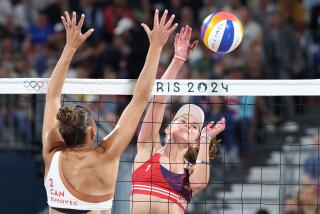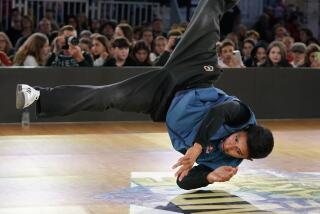BEACH VOLLEYBALL
The growth of beach volleyball has led to another milestone: its inclusion as an Olympics event for the first time.
Following The Hits
Typically the ball is hit in this order
1. Serve: Players can serve from from anywhere behind the end line.
Jump Serve: Server jumps and hits ball with a wrist snap, servers can control spin of the ball, depending on wind conditions and opponents.
Floater Serve: Server hits ball with no spin as it travels across the net. Like a knuckle ball pitch, it drops or rises quickly and unpredictably.
2. Pass: First contact with ball. Passer often hits ball with forearms extended in v-shape. (large drawing to left)
3. Set: Setter places hands above head and places ball with every little spin for hitter.
4. Hit: Any action to direct the ball toward the opponent. Players try to hit to the open court.
Spike: Player jumps and hits down with force. If ball is not returned itâs a kill.
5. Block: To defend against a hit, defensive player at net raises both arms straight above head and jumps. See detail below.
Explaining The Terms
Scoring: Only the team with the ball can score a point. Teams play one game to 15 points and must win by two. In medal round, teams play best of three games to 12 points.
Sideout: Team receiving serve wins rally and earns serve.
Service Ace: Any serve that is not received by an opponent, earning a point.
Transition attack: When the serving team scores with a kill.
Dig: Ball brought up with any part of the body, especially from a spike attempt.
Uniforms
Men: Usually shirts are optional. However, at the Olympics, the men will wear tank tops and shorts.
Women: One-and two-piece bathing suits will be worn.
Source: John Kessel, USA Volleyball; Researched by WENDY WITHERSPOON / Los Angeles Times
More to Read
Go beyond the scoreboard
Get the latest on L.A.'s teams in the daily Sports Report newsletter.
You may occasionally receive promotional content from the Los Angeles Times.







